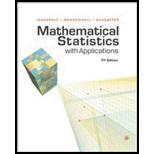
a.
Calculate the values of
a.
Answer to Problem 78E
The value of
The value of
Explanation of Solution
Calculation:
Consider that
Then, the marginal probability
In the given problem
Hence, using the joint probability distribution the marginal probability distribution of
Thus, the marginal density function for
Similarly, using the joint probability distribution the marginal probability distribution of
Thus, the marginal density function for
The expectation of
Thus, the value of
The expectation of
Thus, the value of
b.
Calculate the values of
b.
Answer to Problem 78E
The value of
The value of
Explanation of Solution
Calculation:
The variance of any random variable,
Now,
Thus, the variance is calculated below:
Thus, the value of
Now,
Thus, the variance is calculated below:
Thus, the value of
c.
Find the value of
c.
Answer to Problem 78E
The value of
Explanation of Solution
Calculation:
For any two random variables,
Thus, using the values obtained in Part a, the value of
d.
Calculate the value of
Give the
d.
Answer to Problem 78E
The value of
The values of
Explanation of Solution
Calculation:
The value of
Now, using the values obtained in Parts b and c, it can be said that,
The calculation of
Thus,
Thus, the value of
Tchebysheff’s theorem:
According to Tchebysheff’s theorem discussed in Exercise 1.32, the fraction of observations lying within the interval
For the 2-standard deviations interval about the mean,
In this case,
The interval
About 75% of the scores must fall in the above interval.
Hence, most of the values of
Want to see more full solutions like this?
Chapter 5 Solutions
Mathematical Statistics with Applications
- Show all workarrow_forwardplease find the answers for the yellows boxes using the information and the picture belowarrow_forwardA marketing agency wants to determine whether different advertising platforms generate significantly different levels of customer engagement. The agency measures the average number of daily clicks on ads for three platforms: Social Media, Search Engines, and Email Campaigns. The agency collects data on daily clicks for each platform over a 10-day period and wants to test whether there is a statistically significant difference in the mean number of daily clicks among these platforms. Conduct ANOVA test. You can provide your answer by inserting a text box and the answer must include: also please provide a step by on getting the answers in excel Null hypothesis, Alternative hypothesis, Show answer (output table/summary table), and Conclusion based on the P value.arrow_forward
- A company found that the daily sales revenue of its flagship product follows a normal distribution with a mean of $4500 and a standard deviation of $450. The company defines a "high-sales day" that is, any day with sales exceeding $4800. please provide a step by step on how to get the answers Q: What percentage of days can the company expect to have "high-sales days" or sales greater than $4800? Q: What is the sales revenue threshold for the bottom 10% of days? (please note that 10% refers to the probability/area under bell curve towards the lower tail of bell curve) Provide answers in the yellow cellsarrow_forwardBusiness Discussarrow_forwardThe following data represent total ventilation measured in liters of air per minute per square meter of body area for two independent (and randomly chosen) samples. Analyze these data using the appropriate non-parametric hypothesis testarrow_forward
- Algebra & Trigonometry with Analytic GeometryAlgebraISBN:9781133382119Author:SwokowskiPublisher:Cengage
 Linear Algebra: A Modern IntroductionAlgebraISBN:9781285463247Author:David PoolePublisher:Cengage Learning
Linear Algebra: A Modern IntroductionAlgebraISBN:9781285463247Author:David PoolePublisher:Cengage Learning Elements Of Modern AlgebraAlgebraISBN:9781285463230Author:Gilbert, Linda, JimmiePublisher:Cengage Learning,
Elements Of Modern AlgebraAlgebraISBN:9781285463230Author:Gilbert, Linda, JimmiePublisher:Cengage Learning,  Elementary Linear Algebra (MindTap Course List)AlgebraISBN:9781305658004Author:Ron LarsonPublisher:Cengage Learning
Elementary Linear Algebra (MindTap Course List)AlgebraISBN:9781305658004Author:Ron LarsonPublisher:Cengage Learning Elementary Geometry For College Students, 7eGeometryISBN:9781337614085Author:Alexander, Daniel C.; Koeberlein, Geralyn M.Publisher:Cengage,
Elementary Geometry For College Students, 7eGeometryISBN:9781337614085Author:Alexander, Daniel C.; Koeberlein, Geralyn M.Publisher:Cengage, Elementary Geometry for College StudentsGeometryISBN:9781285195698Author:Daniel C. Alexander, Geralyn M. KoeberleinPublisher:Cengage Learning
Elementary Geometry for College StudentsGeometryISBN:9781285195698Author:Daniel C. Alexander, Geralyn M. KoeberleinPublisher:Cengage Learning





